|
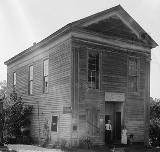
Masonic Temple
Pleasant Ridge Topics
First Settlers
Plantations and Landmarks
Snedecor's Directory
Civil War Fatalities
Voter Precincts
Overview
1.
Havana
2. New Prospect
3. Five Mile
4. Greensboro
5. Newbern
6. Hollow Square
7. German Creek
8. Forkland
9. Garret's Shop
10. Eutaw
11. Springfield
12. Knoxville
13. Union
14. Pleasant Ridge
15. Mount Hebron
16. Clinton
17. Boligee
Mantua
|
Pleasant Ridge
Plantations & Landmarks
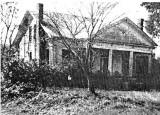 |
Cockrell-Steele House
In 1860 Macklin Cockrell built this house and he sold it to
Andrew S. Steele in 1869, according to Mrs. Mary Grantham
Marshall, the last owner and occupant. In 1894 the Granthams
bought the place.
It is a one and a half story frame building with a gable
roofed front porch supported by four square (actually
octagonal) columns. The house has a center hall with two rooms
on each side on the first floor and only two room upstairs. It
has large rooms with high ceilings (about fourteen feet) and
massive sliding doors between them. An ell extends from the
rear of the house with a porch along it and across the back
with its roof supported by square columns that match those on
the front porch.
This house is one of the few remaining examples of a style
that was popular in Pleasant Ridge. The Archibald house, which
was like it, has been demolished. It was the last visible
reminder of the family of educators who ran the Union Academy
in Pleasant Ridge in 1850. Pleasant Ridge, formerly known as
Sipsey Ridge, has an interesting history and once was the
location of several antebellum homes.
Unfortunately the Cockrell-Steele house has suffered from a
lack of maintenance. It is structurally sound, but it needs
restoration. This house also lacks fire protection.
Historical data for this house was researched by the Greene
County Historical Society. It is shown as a dot on Snedicor's
1856 Map of Greene County.
This house was also demolished after Mrs. Marshall's death in
1987.
Provided by Scott Owens
|
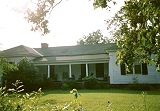 |
Horton-Summerville House
Map Horton-Summerville House
Moses Horton's house sold to Henry Summerville.
Picture taken about 1995, and provided by Scott Owens.
|
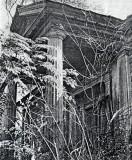
|
Jones House
Previously located in Pleasant Ridge on West Greene Road, this
house was purportedly built by a gambler who died from
gunshot.
The house was then purchased by Henry G. Jones (1800-1870)
& wife Sarah Kennedy; speculation allows that Edmund J.
Jones (1782-1856) & wife Mildred Murphy, may have been the
buyers.
Both Jones families lived in Pleasant Ridge in close
proximity to each other.
It is a one story frame house with plastered interior walls, a high bricked foundation, and two
porches. The front porch had four fluted Doric columns (two
are long gone) and the side porch has two matching columns. The
cornices and eaves are decorated with wood dentils and the
porch ceilings are coffered.
Photo provided by Scott Owens
|

|
Jones House - 2006
Beautifully restored, Henry G. Jones' house was moved into Eutaw and
is now known as the "Sipsey William B. Willis" house.
|
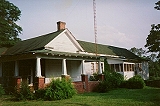
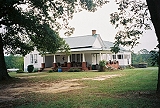
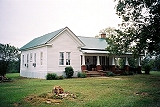
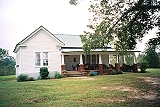
|
Everett C. Owens, Sr. and Bessie Harkness Horton Owens
Built about 1900
Pictures were taken by Scott Owens in 2005.
Currently in use by the Full Draw Hunting Club.
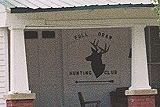 |
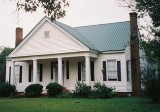 |
Owens-Hutton Home (1940s)
Listed on the Alabama Register of Landmarks and Heritage -
Owens-Hutton Home HWY 14, 17 miles north of Eutaw.
Hugh Lafayette Owens purchased this home in the early 1900's; later
the Elmo Owens family lived there. The James Wilton Owens
family lived there from 1935 until 1964. The home was built
on the site where the organization of the Pleasant Ridge
Presbyterian Church took place in 1848; services were held
there until the church building was built in 1859. |
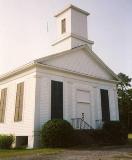
Pleasant Ridge
Presbyterian Church before addition of porch
Historic Marker
Sign at church |
Pleasant Ridge Presbyterian Church
Historic Marker Text:
By appointment of Tuscaloosa Presbytery, Nov. 18, 1848 Rev.
J. L. Kirkpatrick and Rev. C. A. Stillman organized a
Presbyterian Church at Pleasant Ridge, Alabama. There were 13
charter members. Services were held in a home near site of
present church.
The first pastor, Rev. J. P. McMullen, served from 1855
until he was killed while serving the Confederacy at Resaca,
Ga. 1864. The church building erected 1859, has been a
blessing to all who have worshipped here through the years.
|

Sipsey Ridge 1992
photo: Scott Owens |
Sipsey Ridge was originally settled by James Hall Archibald.
|
 |
Summerville Store
Submitted by Scott Owens
This is the Antique and General store operated by Mr. Thomas Taylor
Summerville during my childhood. It no longer stands, but was
there for a while. My daddy told me that when a boy he would
loop a rope from a sled around the rear bumper of a a Model T
stopped out in front of the store and get a ride down the road
for a ways. This ended when one day he looked up onto the
porch and there sat his daddy.
From what I understand the store was built by William Horton
(son of Jesse) in the 1870's after he purchased the house
behind. It was operated by William's son Amos, and then by
his son William Taylor Horton, who was the owner when Daddy
was riding sleds behind cars. Cousin Taylor and Eliza Mary
Poyner were childless, and during the Depression I was told
that they took in her nephew, Thomas Summerville, to help H.B.
and Mattie (her sister) Summerville, who had several
children. After Cousin Taylor's death in 1949, the store came
into Mr. Thomas' possession. He operated it as a general
store (it and Crooks Schiver's across the road were the only
stores in Pleasant Ridge when I was a child--o.k., there was
Mr. Homer Carpenter's store past the lake, operated by Mr.
Eugene Jones--it, too, is gone). In later years Mr. Thomas
took to restoring and selling antique furniture. It closed
after his death.
From Bill Horton regarding the Summerville Store:
Uncle Taylor Horton's store which Scott Owens refers to may or may
not have been built by William Horton. Amos Horton and his
sons, Charles Richardson and William Taylor operated a
business but I can not say for a fact that the business was in
this store. The home was built by a Mr. Westmoreland and was
destroyed by a tornado in 1898 and it was not Uncle Taylor's
home at that time. William Horton had been dead several years
by then. It is more likely that Amos Horton built the store if
Mr. Westmoreland did not build it.
It is worth mentioning too that Mr. Will Steele had a
commissary as did Mr. Everett Owens, Scott's grandfather. Both
these stores were there to serve the people who worked for
them and it is highly possible this old store was Mr.
Westmoreland's commissary.
Uncle Taylor and Mr. Will Steele were partners in the store
and were life long friends. I remember the two of them
visiting for hours on the front porch of the store, discussing
the crops, mules, hired hands, the weather and of course
politics.
They decided to dissolve the partnership and divided the
assets in an little different way. They rolled the dice for
every item - horse collars, bolts of cloth, cotton sacks,
candy bars, cans of tobacco, bottles of snuff, well buckets,
single trees, pony plows, Sloan's Liniment, sacks of flour,
cans of molasses etc. etc. They had their farm hands there and
as each item was rolled for it was promptly loaded on the
winners wagon. Uncle Taylor said the division took two days
with everybody on the Ridge looking on and rooting for one or
the other rollers. |
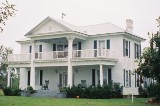 |
Westmoreland House CA 1845
Former home of the Thomas Taylor Summerville family. |
Sources:
ADAH Historic Markers
Alabama Register
of Landmarks and Heritage
|